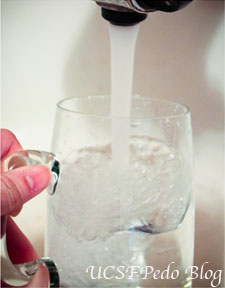Article content by T.Le.; Edited by R. Warotayanont
 Recent media articles from LA times and Fox news have raised public concerns regarding the level of fluoride in drinking water. Parents have come and asked us what our opinion is regarding the level of fluoride in water and the risk of fluorosis development. Does fluoridated water still help protect the teeth or should we avoid drinking it if possible? As reported in the news articles, the U.S. Environmental Protection Agency (EPA) has planned for the first time in 50 years to reduce the recommended level of fluoride in water to no more than 0.7 ppm, due to the reportedly increasing incidence of fluorosis in children at the age group of 12-15 years old. How exactly does fluoride work and when and how might fluorosis occur? Does it really cause primarily by excessive level fluoride in water? We will discuss these issues here.
Recent media articles from LA times and Fox news have raised public concerns regarding the level of fluoride in drinking water. Parents have come and asked us what our opinion is regarding the level of fluoride in water and the risk of fluorosis development. Does fluoridated water still help protect the teeth or should we avoid drinking it if possible? As reported in the news articles, the U.S. Environmental Protection Agency (EPA) has planned for the first time in 50 years to reduce the recommended level of fluoride in water to no more than 0.7 ppm, due to the reportedly increasing incidence of fluorosis in children at the age group of 12-15 years old. How exactly does fluoride work and when and how might fluorosis occur? Does it really cause primarily by excessive level fluoride in water? We will discuss these issues here.
How does fluoride work?
Fluoride works primarily by topical interaction between fluoride ions and enamel surface apatite. The natural occurring enamel consists of readily soluble carbonated hydroxyapatite. In the presence of fluoride, fluoride ions (F-) incorporate into carbonated apatite crystals, resulting in much stronger fluoroapatite crystals, which resist demineralization from acidogenic bacteria.
In addition, fluoride promotes remineralization by facilitating the addition of calcium and phosphate molecules onto the carious lesion. Lastly, fluoride has an anti-bacterial effect, which helps preventing bacteria from secreting harmful lactic acid.
Water fluoridation
Numerous clinical and epidemiological studies have strongly supported the fact that water fluoridation is the most cost-effective way in caries prevention. Although fluoride is proven beneficial to the teeth, like other chemicals, excessive and chronic ingestion of fluoride can cause adverse reactions. Fluoride in water at the level of 0.7-1.0 ppm is considered safe and effective to deliver appropriate level of F- to the tooth surface. However, excessive ingestions of fluoride from other sources in conjunction with fluoridated water, can cause fluorosis. Such excessive ingestions are particularly risky in children at the ages between 3 months and 8 years, when the permanent teeth are developing and are sensitive to excess fluoride intake.
The adjunct effects of chronic ingestion of fluoride from other sources is also known as the ‘halo effect’. The amount of fluoride intake as well as the source of the fluoride ingestion (fluoride tooth paste, fluoride mouth rinse, and/or fluoride-containing food) are crucial when determining the cause of fluorosis, yet these factors are unidentifiable and unmeasurable, hence the term halo. For example, indigestion of fluoride toothpaste, especially in young children, is often unintentional. It is this halo effect plus the intake of fluoridated water that may have caused fluorosis.
What are these other sources of fluoride, other than water?
There are many published articles regarding the source of fluoride. Apart from the fluoride toothpaste and fluoride mouth rinse available in the market, considerable amount of fluoride is also present in foods and beverages including fruit juice, vegetable, cereal, infant formulas etc. Examples of fluoride containing foods can be found here.
How to avoid fluorosis? And where do we go from here? What’s the bottom line?
Let’s start from restating what we have said thus far.
1. Fluoridated water at the level of 0.7-1.0 ppm is safe, inexpensive, and effective in caries prevention. This level alone should not be the primary cause of fluorosis development.
2. Excessive fluoride intake in children age 3 months to 8 years can cause fluorosis. It is this halo effect in conjunction with fluoridated water that may have caused fluorosis. Unfortunately, the sources of the chronic ingestion of fluoride in each individual is difficult to identify, so is the exact amount of this excessive fluoride.
Therefore, to avoid fluorosis development, individuals should focus on avoiding excessive intake of fluoride from known sources, such as avoid ingesting toothpaste, and mouth rinse, especially in the age group at risk.
Future research shall focus on determining the optimum amount of fluoride intake, both from water and other sources, to be effective enough for caries prevention, and safe enough to avoid fluorosis development.